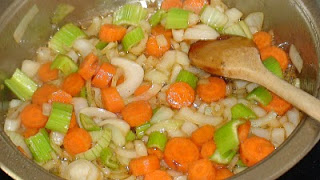Once your meat is done to crumbling goodness, it's time to get the gravy done.
Using some tongs, take out the pieces of meat and then pour the rest of the liquid with the cooked bits of vegetables and herbs into a sieve, letting the liquid run into a stainless steel pot (not aluminium, ever). The meat can be placed on a platter, covered with foil, into a slightly warm oven. Using a wooden spoon, mash the vegetables into the sieve to get as much of the liquid out as possible. (This makes a delicious addition to our dog's dinner.)
Now return the pot with the gravy liquid to the stove. Let it boil rapidly for about 5 minutes then remove from heat. Let it cool down slightly and then, using a deep spoon, skim off most of the fat you can.
Return the pot to the heat and let it gently simmer. For about 1/2 litre (which is what you'll get with 400ml vermouth and 400ml stock plus some boiling water), mix 2 tablespoons of corn flour (Maizena) and a little vermouth just enough to dissolve it. Add this gradually to the gravy while whisking. Let it simmer gently for about 5 minutes. Taste for salt. If it seems a bit "tarty" add 1/2 tablespoon sugar and re-taste.
Pour through a clean sieve again into a gravy boat OR over the meat.
Have some nice fresh bread handy to mop up the gravy juices :)
Wednesday, October 13, 2010
The basic french cooking method for braised meat
This basic method is used for braising meat (lamb/beef/pork) and makes delicious stews (where the meat is cut into blocks) or whole meat cuts.
I used very thickly cut pieces of lamb chops from the friendly Pick n Pay butcher.
First the meat is browned well on all sides in a pan covered in a film of normal vegetable oil. Be careful that the oil does not burn so you may want to turn down the heat a bit if it gets smoky. Do not use olive oil since it has too strong a flavour. Do this in batches and as they are finished put them into a big enough oven casserole dish (with lid).

Next you add one chopped onion, one sliced carrot (I used 2 since they were a bit skinny) and 2 sliced stalks for celery (1 was too skinny again) to the same oil in the pan. Fry these lightly over medium heat until the onion soften. Be very careful not to burn / toast the onion.
Strew the vegetables over the meat pieces in the casserole dish. Since I made a big dish for 5 people I used 12 lamb cuts and this barely fit into a very large roasting tin. For this amount I used 400ml extra dry vermouth (that's Cinzano for those who have to discover this like I had to :) ) with 400ml beef stock (one beef stock block dissolved in boiling water) in which you stirred 1 tablespoon crushed garlic. Pour this over the meat pieces. If the pieces are sticking out too much, add a little more boiling water. They can stick out by about 5mm.
Into the liquid push 5-6 twigs of thyme and 4-5 twigs of parsley. (Remember this is for quite a large dish.)
Before you put the lid on, take a piece of foil big enough to cover the top and put that over first. Then put the lid on. It provides a nice seal so you don't lose any liquid through evaporation.
Put this into a pre-heated oven of about 160C and cook for about 3 hours. (Or more if you like your meat to fall apart). Check about every hour just to make sure everything is still nice a bubbly.
NEXT: How to finish off your dish with a nice gravy
Wednesday, October 6, 2010
Scrambled eggs with a tropical twist
I made a lentil curry the other day and it gets coconut cream in it right at the end. The first time I made it, I added the whole tin and it was way too much and we ended with a lentil-curry-soup. So now I just add a couple of tablespoons to give it the nice flavour and colouring. But there's not much I can do with left-over coconut cream so yesterday, in a flash of inspiration, I added about 2 heaped tablespoons (if the cream has thickened) to my scrambled eggs (4) as I was scrambling them. It was delicious!
4 eggs, lightly beaten
2 tablespoons thickened coconut cream
Add to heated non-stick pan and scramble as usual.
Bon Appetit!
4 eggs, lightly beaten
2 tablespoons thickened coconut cream
Add to heated non-stick pan and scramble as usual.
Bon Appetit!
Tuesday, October 5, 2010
The Ribbon
In some cake and dessert recipes you have to seperate the yolks and egg whites from each other. The whites are usually beaten stiff and added at the end to lighten your batter (see tips in http://redcuisine.blogspot.com/2010/09/egg-white-disaster.html). For fresh handmade custards and custard-type desserts such as Crème Brûlée, you only use the yolks. Here is a very nice, easy recipe: http://www.cremebrulee.com/creme.htm
In Mastering the Art of French Cooking and in Julia Child's cooking show (available on DVD on Kalahari.net / Amazon.com / etc) she shows how yolks and sugar are beaten to form "a ribbon". This takes a little time and you know you're getting to the end when the yolks and sugar are beaten to a pale yellow colour. And when you lift the beater you'll see the mixture make a beautiful ribbon that falls gentle into the rest of it. Magnifique.

Subscribe to:
Posts (Atom)

